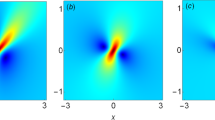Abstract
In this paper, we focus on the construction of rogue wave solutions for the (2+1)-dimensional derivative nonlinear Schrödinger equation. The N-order generalized Darboux transformation is obtained, and the determinant form of N-order rogue waves is also presented by taking limit on the classical Darboux transformation. On the plane wave solution background, two different kinds of rogue wave solutions (linear rogue wave and parabolic rogue wave) are constructed successively. The characteristics of two types of rogue waves are analyzed by some figures and physical qualities.






Similar content being viewed by others
References
Kharif, C., Pelinovsky, E.: Physical mechanisms of the rogue wave phenomenon. Eur. J. Mech. B-Fluids 22, 603–634 (2003)
Akhmediev, N., Ankiewicz, A., Soto-Crespo, J.M.: Rogue waves and rational solutions of the nonlinear Schrödinger equation. Phys. Rev. E 80, 026601 (2009)
Broad, W.J.: Rogue Giants Sea. The New York Times, New York (2006)
Akhmediev, N., Pelinovsky, E.: Editorial-introductory rematrks on discussion debate rogue waves-towards a unifying concept. Eur. Phys. J. Spec. Top. 185, 1–4 (2010)
Osborne, A.R.: Nonlinear Ocean Waves. Academic Press, New York (2009)
Pelinovsky, E., Kharif, C.: Extreme Ocean Waves. Springer, Berlin (2008)
Chabchoub, A., Hoffmann, N.P., Akhmediev, N.: Rogue wave observation in a water wave tank. Phys. Rev. Lett. 106, 204502 (2011)
Solli, D.R., Ropers, C., Koonath, P., Jalali, B.: Optical rogue waves. Nature 450, 1054–U7 (2007)
Kibler, B., Fatome, J., Finot, C., Millot, G.: The peregrine soliton in nonlinear fibre optics. Etal. Nat. Phys. 6, 790–795 (2010)
Bailung, H., Sharma, S.K., Nakamura, Y.: Observations of peregrine solitons in a multicomponent plasma with negative lons. Phys. Rev. Lett. 107, 255005 (2011)
Onorato, M., Residori, S., Bortolozzo, U., Montina, A., Arecchi, F.T.: Rogue waves and their generating mechanisms in different physical contexts. Phys. Rep. 528, 47–89 (2013)
Ganshin, A.N., Efimov, V.B., Kolmakov, G.V., Mezhov-Deglin, L.P., McClintock, P.V.E.: Observation of an inverse energy cascade in developed acoustic turbulence in superfluid helium. Phys. Rev. Lett. 101, 065303 (2008)
Stenflo, L., Marklund, M.: Rogue waves in the atmosphere. J. Plasma Phys. 76, 293–295 (2010)
Yan, Z.Y.: Vector financial rogue waves. Phys. Lett. A 375, 4274–4279 (2011)
Lü, X., Peng, M.S.: Painlevé-integrability and explicit solutions of the general two-coupled nonlinear Schrödinger system in the optical fiber communications. Nonlinear Dyn. 73, 405–410 (2013)
Akhmediev, N., Ankiewicz, A.: Solitons: Nonlinear Pulses and Beams. Chapman and Hall, London (1997)
Kivshar, Y.S., Agrawal, G.P.: Optical Solitons, from Fibers to Photonic Crystals. Academic Press, New York (2003)
Barnett, M.P., Capitani, J.F., Von Zur Gathen, J.: Symbolic calculation in chemistry: selected examples. Int. J. Quantum Chem. 100, 80–104 (2004)
Matveev, V.B., Salle, M.A.: Darboux Transformation and Solitons. Springer, Berlin (1991)
Guo, R., Liu, Y.F., Hao, H.Q., Qi, F.H.: Coherently coupled solitons, breathers and rogue waves for polarized optical waves in an isotropic medium. Nonlinear Dyn. 80, 1221–1230 (2015)
Qi, F.H., Ju, H.M., Meng, X.H., Li, J.: Conservation laws and Darboux transformation for the coupled cubic-quintic nonlinear Schrödinger equations with varable coefficients in nonlinear optics. Nonlinear Dyn. 77, 1331–1337 (2014)
Zhao, H.H., Zhao, X.J., Hao, H.Q.: Breather-to-soliton conversions and nonlinear wave interactions in a coupled Hirota system. Appl. Math. Lett. 61, 8–12 (2016)
Guo, R., Hao, H.Q., Zhang, L.L.: Dynamic behaviors of the breather solutions for the AB system in fluid mechanics. Nonlinear Dyn. 74, 701–709 (2013)
Guo, R., Hao, H.Q.: Breathers and localized solitons for the Hirota–Maxwell–Bloch system on constant backgrounds in erbium doped fibers. Ann. Phys. 344, 10–16 (2014)
Guo, B.L., Ling, L.M., Liu, Q.P.: Nonlinear Schrödinger equation: generalized Darboux transformation and rogue wave solutions. Phys. Rev. E 85, 026607 (2012)
Guo, B.L., Ling, L.M., Liu, Q.P.: High-order solutions and generlized Darboux transformations of derivative nonlinear Schrödinger equations. Stud. Appl. Math. 130, 317–344 (2013)
Wen, L.L., Zhang, H.Q.: Darboux transformation and soliton solutions of the (2+1)-dimensional derivative nonlinear Schrödinger hierarchy. Nonlinear Dyn. 84, 863–873 (2016)
Acknowledgments
This work is supported by the Shanghai Leading Academic Discipline Project under Grant No. XTKX2012, by the Technology Research and Development Program of University of Shanghai for Science and Technology, by Hujiang Foundation of China under Grant No. B14005 and by the National Natural Science Foundation of China under Grant No. 11201302.
Author information
Authors and Affiliations
Corresponding author
Appendix: Choose the special solution
Appendix: Choose the special solution
Firstly, we need to solve the linear system (2) with the seed solution by the gauge transformation method:
where
Then, matrix \(\varPhi \) satifies the following linear system:
where
And (7a) could be rewrited as
By some calculations, i.e., (8a)+(8b) and (8a)-(8b), we could have
For convenience, \(\phi _2-\phi _1\) and \(\phi _2+\phi _1\) are marked as R and K, respectively. Therefore, from (9a) and (9b), we could deriving that
Next, inserting K and R into \(\phi _2-\phi _1=R\) and \(\phi _2+\phi _1=K\), we could obtained
Now, simultaneous Eq. (7b) and \(\phi _{i}(i=1,2)\), \(a_1(t,y)\) and \(a_2(t,y)\) could be derived:
where \(f\left( \lambda ^2 t+y\right) \) and \(g\left( \lambda ^2 t+y\right) \) are arbitrary complex functions about \(\lambda ^2 t+y\). The different solutions could be derived by changing \(f\left( \lambda ^2 t+y\right) \) and \(g\left( \lambda ^2 t+y\right) \). Then, \(\varphi _{1}\) and \(\varphi _{2}\) could be derived.
Rights and permissions
About this article
Cite this article
Wen, LL., Zhang, HQ. Rogue wave solutions of the (2+1)-dimensional derivative nonlinear Schrödinger equation. Nonlinear Dyn 86, 877–889 (2016). https://doi.org/10.1007/s11071-016-2930-y
Received:
Accepted:
Published:
Issue Date:
DOI: https://doi.org/10.1007/s11071-016-2930-y




